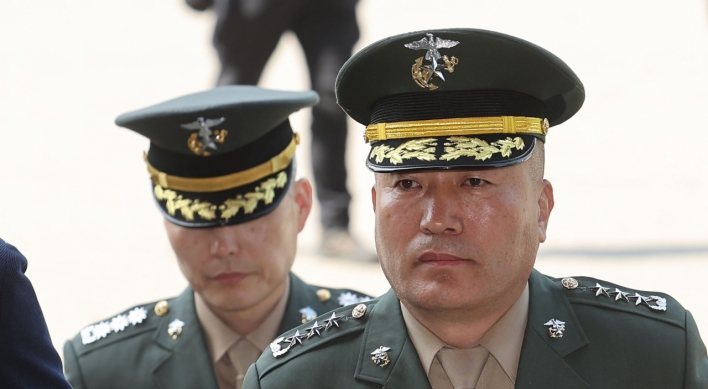South Korean factory owners crossed into North Korea on Monday as the joint Gaeseong industrial zone reopened five months after it was shut down by threats of war.
After weeks of often spiky negotiations aimed at easing inter-Korean tensions, dozens of cars, trucks and management staff crossed the border shortly after 8:30 a.m.
“I hope we can work together well again, just like before,” said the 50-year-old head of a Seoul textile company who declined to be named.
The optimistic mood at the border checkpoint contrasted sharply with the sense of impending disaster that had loomed over the closure of Gaeseong back in April.
Months of heightened military tensions, with Pyongyang issuing apocalyptic threats of nuclear strikes, saw North Korea withdraw its 53,000-strong workforce from the joint industrial zone.
After weeks of often spiky negotiations aimed at easing inter-Korean tensions, dozens of cars, trucks and management staff crossed the border shortly after 8:30 a.m.
“I hope we can work together well again, just like before,” said the 50-year-old head of a Seoul textile company who declined to be named.
The optimistic mood at the border checkpoint contrasted sharply with the sense of impending disaster that had loomed over the closure of Gaeseong back in April.
Months of heightened military tensions, with Pyongyang issuing apocalyptic threats of nuclear strikes, saw North Korea withdraw its 53,000-strong workforce from the joint industrial zone.

The mood on the peninsula has eased significantly since then, although the underlying concerns about the North’s nuclear ambitions remain.
Analysis of recent satellite images suggests the North has restarted the plutonium reactor that provided the fissile material for at least two of its three nuclear tests.
During talks on re-opening Gaeseong, the North accepted the South’s demand that efforts be made to encourage foreign investment.
Seoul believes having vested interests outside the Korean peninsula involved in Gaeseong will make it harder for Pyongyang to shut down the complex the next time North-South relations go into freefall.
“Honestly, I still feel a bit nervous because you never know whether the North will change its mind in the future,” the textile company manager told AFP.
Born out of the “sunshine” reconciliation policy initiated in the late 1990s by then-South Korean president Kim Dae-jung, Gaeseong was established in 2004 as a rare symbol of inter-Korean cooperation.
It provided an important hard currency source for the impoverished North through taxes, other revenues, and its cut of workers‘ wages.
It had appeared immune to previous downward spirals in North-South relations, but finally fell victim to the crisis that followed the North’s nuclear test in February.
Pyongyang initially barred South Korean entry to the park in early April and shortly afterwards withdrew its workers ― effectively closing down the complex, which houses production lines for 123 South Korean firms.
The most immediate task for the South Korean managers is to inspect the state of production lines that have been out of operation for nearly five months, and to determine how quickly they can get them up and running again.
The South‘s Unification Ministry said 820 South Korean managers and workers planned to cross the border into Gaeseong on Monday, with more than 400 to stay overnight to oversee production operations.
“I’m glad things have returned to normal finally,” said Shin Han-Yong, the chief executive of the Shinhan Trading company.
“I never believed the complex would be permanently closed. I think things will be alright from now on,” Shin said.
In an effort to prevent any future closures, the North and South have created a joint committee to oversee Gaeseong and deal with any problems related to its operations.
The South Korean co-chairman Kim Ki-woong said future committee talks would focus on ensuring that Gaeseong becomes internationally competitive.
“To reach this goal, there are still quite a few problems to resolve, even though the factory park itself has reopened,” Kim said.
Gaeseong, on paper at least, has always been open to foreign investors although none have taken the plunge and set up business there.
A road show for foreign investors is scheduled to be held in Gaeseong in October, but many experts question who would be attracted by a project jointly run by two countries that are still technically at war.
“What foreign firm in their right mind would consider investing in Gaeseong?” asked Aidan Foster-Carter, a noted Korea expert at Leeds University in Britain.
“There are a myriad separate reasons to steer well clear,” he wrote in a commentary for the Wall Street Journal.
Monday‘s re-opening of Gaeseong is still officially on a “trial basis” as both sides continue to discuss operational issues.
An association representing the South Korean businesses in Gaeseong welcomed the restart but urged the new joint committee to approve “firm measures” to prevent another closure.
The companies say the suspension of operations cost them a collective one trillion won ($920 million) in lost production.
“The past five months have been very hard,” said one textile plant manager who would only identify himself as Kim. (AFP)
-
Articles by Korea Herald



















